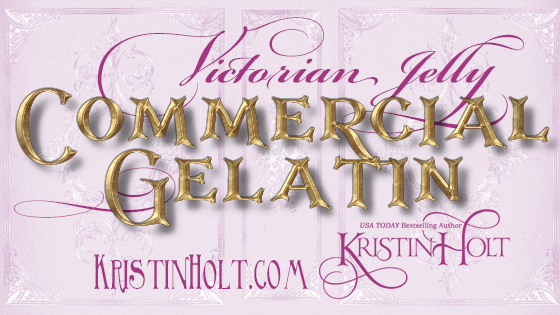
by Kristin Holt | May 28, 2022 | Articles
Credit goes to a Victorian-era inventor for out-of-a-box gelatin. What an amazing labor-saving invention! Until now, wives and daughters everywhere had been making gelatin out of pigs feet and a good deal of elbow grease.
How did nineteenth century scientists manage to capture the essence of gelatin and put it in a box? And how much did it cost?

by Kristin Holt | Aug 25, 2021 | Articles
Nineteenth-century recipes for fruit jellies–the kind spread on toast or between cake layers. Vintage details instruct cooks on jellies (and jams) made of raspberry, cranberry, apple, strawberry, quince, three hues of currant, peach, plum, cherry, gooseberry, and more. How they capped their jelly tumblers might surprise you…

by Kristin Holt | Aug 10, 2018 | Articles
Cool, inexpensive dessert recipes appealed to our Victorian grandmothers, especially in summertime heat. These three recipes, published in the Saint Paul Globe of Saint Paul, Minnesota on June 24, 1888 were perfect for a cameo appearance in my Holidays in Mountain Home title 8– Unmistakably Yours.

by Kristin Holt | Feb 12, 2017 | Articles
Featured in my soon-to-be-released title, Sophia’s Leap-Year Courtship, is my heroine Sophia Amelia Sorensen. I didn’t pull that name out of a hat…or off a list of most-common names from her birth decade (my usual practice). I borrowed my great-great grandmother’s name…and her cookie jar.

by Kristin Holt | Aug 23, 2016 | Articles
Victorian Americans needed ice–for home use, through delivery businesses, on a commercial scale (to keep food from spoiling at the grocery and in railroad transportation). Ice houses were built all over the United States from the independent family’s ice house on their property to the enormous commercial Swift & Co. Ice House storing 60,000 tons annually. Ice harvesting occurred in January and February and kept in storage facilities until the following winter by applying ingenuity, science, and hard work. Men used saws, horse-drawn sleighs, and the strength of their own backs to harvest the cash crop each winter. This article contains vintage photographs, newspaper ads, and science info of the Victorian era.













